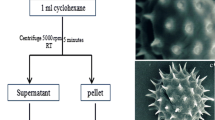Summary
Production of stigma exudate per flower of Petunia hybrida is about 200 μg. The effect of light, temperature, metabolic poison and emasculation on the production of the exudate at different ages of the bud has been studied. The presence of a thin film of water below the stigmatic exudate has been demonstrated. Physical properties of the exudate such as relative viscosity and surface tension have also been determined. Chemical analysis of the stigmatic fluid showed that it consists primarily of an oil, sugars and amino acids. No protein could be detected. It also contains no acid phosphatase.
Behaviour of the pollen from its deposition on the stigmatic fluid until it germinates on the stigma surface has been studied in vivo and also with the aid of an “artificial stigma”.
The role of the stigmatic fluid in pollination has been determined.
Zusammenfassung
Die Narbenflüssigkeit, welche von zahlreichen Pflanzen ausgeschieden wird zu einem Zeitpunkt, da die Blüte reif ist zur Bestäubung, spielt eine wichtige Rolle bei der Fixierung des Pollens. Um so überraschender ist die Tatsache, daß hinsichtlich der Physiologie und Biochemie des Narbenschleimes so wenig detaillierte Informationen zur Verfügung stehen.
Bei Petunia wird je Blüte im Mittel 200 μg Narben-Flüssigkeit produziert. Die Intensität der Narbenschleimproduktion ist abhängig von der Temperatur und der Länge der Lichtperiode. Hingegen wird die Ausscheidung der Narbenflüssigkeit durch Hemmung der Atmung und durch partielle Kastration nicht beeinflußt.
Die physikalischen Eigenschaften (Dichte, relative Viscosität und Oberflächenspannung) werden bestimmt. Bei der chemischen Analyse des Narbenschleimes ergab sich, daß dieser hauptsächlich aus einem öligen Fett besteht, dessen Fettsäure-Zusammensetzung ermittelt wurde. Hingegen werden nur sehr geringe Spuren von Zuckern und Aminosäuren gefunden. Der Narbenschleim ist frei von Proteinen und zeigt keine enzymatische Aktivität.
Das Verhalten des Pollens bei der “Landung” in einem Tropfen der Narbenflüssigkeit wird in vivo und mit Hilfe einer künstlichen “Modell-Narbe” untersucht.
Die Bedeutung der Narbenflüssigkeit im Zusammenhang mit der Bestäubung und den einleitenden Stadien der Pollenkeimung wird diskutiert.
Similar content being viewed by others
Literature
Burck, W.: Over de prikkelbare stempels van Torenia fournieri en Mimulus luteus en over voorbehoedmiddelen tegen het kiemen van vreemd stuifmeel op de stempel. Versl. Wis. Nat. Afd. Akad. Wetensch. Amsterd. 10, 209–219 (1902).
Cappelletti, C.: Biological studies of Lilium candidum. Atti Accad. naz. Lincei, Mem. Cl. Sci. fisiche, mat. natur. 4, 1–94 (1953).
Daumann, E.: Nektarabscheidung in der Blütenregion einiger Araceen. Zugleich ein Hinweis auf die Bargersche Methode. Planta (Berl.) 12, 20–38 (1931).
Freytag, K.: Doppelbrechende und leicht lösliche Lipoide in Zellwänden der Narbenpapillen verschiedener Blütenpflanzen. Z. Bot. 47, 114–120 (1958).
Gärtner, C.F.: Beiträge zur Kenntnis der Befruchtung der vollkommenen Gewächse. Erster Teil: Versuche und Beobachtungen über die Befruchtungsorgane der vollkommenen Gewächse und über die natürliche und künstliche Befruchtung durch den eigenen Pollen, S. 1–644. Stuttgart: E. Schweizerbart 1844.
Glick, D.: Techniques of histo- and cytochemistry. New York: Intersci. Publ. 1949.
Heinen, W., and H. de Vries: A combined micro- and semimicro colorimetric determination of long chain fatty acids. Arch. Mikrobiol., 54, 339–349 (1966).
Jost, L.: Zur Physiologie des Pollen. Ber. dtsch. bot. Ges. 23, 504–515 (1905).
Jung, J.: Sind Narbe und Griffel Eintrittspforten für Pilzinfektionen?. Phytopath. Z. 27, 405–426 (1956).
—, u. M. Plempel: Über die Hemmwirkung des Gynäzeums bei Primula obconica auf Bakterien und Pilze. II. Phytopath. Z. 38, 245–249 (1960).
Katz, E.: Über die Funktion der Narbe bei der Keimung des Pollens. Flora (Jena) 20, 243–281 (1926).
Konar, R.N., and H.F. Linskens: Some observations on the stigmatic exudate in Petunia hybrida. Naturwissenschaften 52, 625 (1965).
——, H.F. Linskens: The morphology and anatomy of the stigma of Petunia hybrida. Planta (Berl.) 71, 356–371 (1966).
Lingelsheim, A.V.: Zur Biologie der Epipactis Blüte. Beitr. Biol. Pflanz. 17, 297–300 (1929).
Linskens, H.F., and J. Tupý: The amino acids pool in the style of self-incompatible strains of Petunia after self- and cross pollination. Genetics and Breeding Res. 36, 151–158 (1966).
Lüttge, U.: Funktion und Struktur pflanzlicher Drüsen. Naturwissenschaften 53, 96–103 (1966).
McWilliam, J.R.: The role of micropyle in the pollination of Pinus. Bot. Gaz. 120, 109–117 (1958).
Meara, M.L.: Fats and other lipids. In: Mod. Meth. Plant Anal., vol. II, p. 317–402 (eds. K. Paech and M. V. Tracey). Berlin-Göttingen-Heidelberg: Springer 1955.
Miki-Hirosige, H.: A study of tropism of pollen tubes to the pistils. VI. Mem. Coll. Sci., Univ. Kyoto B 29, 75–80 (1962).
Pifferi, P.G.: Improved thin layer chromatographic separation of hexoses and pentoses using Kiselgel G. Analyt. Chem. 37, 925 (1965).
Schoch-Bodmer, H.: Osmotische Untersuchungen an Griffeln und Pollenkörnern von Corylus avellana und Betula pendula. Verh. Schweiz. naturforsch. Ges. 114, 378–380 (1933).
—: Zur Physiologie der Pollenkeimung bei Corylus avellana: Pollen- und Narbensaugkräfte, Quellungserscheinungen der Kolloide des Pollen. Protoplasma (Wien) 25, 337–371 (1936).
Schönbeck, F.: Untersuchungen über die Infektion von Apfelblüten durch Phytophthora cactorum (Leb. et. Cohn) Schroet. Naturwissenschaften 51, 541 (1964).
Shuel, R.W.: Nectar secretion in relation to nitrogen supply, nutritional status, and growth of plant. Canad. J. agr. Sci. 35, 124–138 (1955).
—: Some aspects of the relation between nectar secretion and nitrogen, phosphorus and potassium nutrition. Canad. J. Plant. Sci. 37, 220–236 (1957).
—: Studies of nectar secretion in excised flowers. II. Canad. J. Bot. 37, 1167–1180 (1959).
Sorenson, W.R., and T.W. Campbell: Preparative methods of polymer chemistry. New York: Intersci. Publ. Inc. 1961.
Stahl, E.: Thin layer chromatography — a laboratory handbook. Berlin-Heidelberg-New York: Springer 1965.
Strasburger, E.: Über fremdartige Bestäubung. Jb. wiss. Bot. 17, 50–98 (1886).
Vasil, I.K., and M.M. Johri: The style, stigma and pollen tube. I. Phytomorphology 14, 352–369 (1964).
Ziegler, H.: Über die Zusammensetzung des “Bestäubungstropfens” und den Mechanismus seiner Sekretion. Planta (Berl.) 52, 587–599 (1959).
Author information
Authors and Affiliations
Rights and permissions
About this article
Cite this article
Konar, R.N., Linskens, H.F. Physiology and biochemistry of the stigmatic fluid of Petunia hybrida . Planta 71, 372–387 (1966). https://doi.org/10.1007/BF00396322
Received:
Issue Date:
DOI: https://doi.org/10.1007/BF00396322




